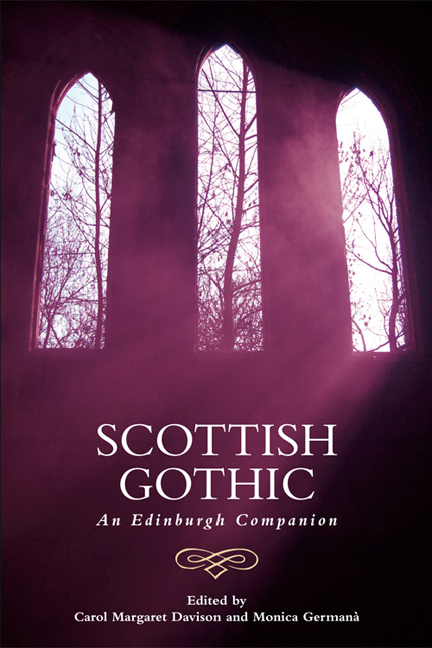Book contents
- Frontmatter
- Contents
- Acknowledgements
- 1 Borderlands of Identity and the Aesthetics of Disjuncture: An Introduction to Scottish Gothic
- 2 ‘The Celtic Century’ and the Genesis of Scottish Gothic
- 3 The Politics and Poetics of the ‘Scottish Gothic’ from Ossian to Otranto and Beyond
- 4 Robert Burns and the Scottish Bawdy Politic
- 5 Scottish Gothic Drama
- 6 Scottish Gothic Poetry
- 7 Calvinist and Covenanter Gothic
- 8 Gothic Scott
- 9 Gothic Hogg
- 10 ‘The Singular Wrought Out into the Strange and Mystical’: Blackwood's Edinburgh Magazine and the Transformation of Terror
- 11 Gothic Stevenson
- 12 J. M. Barrie's Gothic: Ghosts, Fairy Tales and Lost Children
- 13 The ‘nouveau frisson’: Muriel Spark's Gothic Fiction
- 14 Scottish Gothic and the Moving Image: A Tale of Two Traditions
- 15 New Frankensteins; or, the Body Politic
- 16 Queer Scottish Gothic
- 17 Authorship, ‘Ghost-filled’ Islands and the Haunting Feminine: Contemporary Scottish Female Gothic
- Notes on Contributors
- Index
17 - Authorship, ‘Ghost-filled’ Islands and the Haunting Feminine: Contemporary Scottish Female Gothic
Published online by Cambridge University Press: 20 December 2017
- Frontmatter
- Contents
- Acknowledgements
- 1 Borderlands of Identity and the Aesthetics of Disjuncture: An Introduction to Scottish Gothic
- 2 ‘The Celtic Century’ and the Genesis of Scottish Gothic
- 3 The Politics and Poetics of the ‘Scottish Gothic’ from Ossian to Otranto and Beyond
- 4 Robert Burns and the Scottish Bawdy Politic
- 5 Scottish Gothic Drama
- 6 Scottish Gothic Poetry
- 7 Calvinist and Covenanter Gothic
- 8 Gothic Scott
- 9 Gothic Hogg
- 10 ‘The Singular Wrought Out into the Strange and Mystical’: Blackwood's Edinburgh Magazine and the Transformation of Terror
- 11 Gothic Stevenson
- 12 J. M. Barrie's Gothic: Ghosts, Fairy Tales and Lost Children
- 13 The ‘nouveau frisson’: Muriel Spark's Gothic Fiction
- 14 Scottish Gothic and the Moving Image: A Tale of Two Traditions
- 15 New Frankensteins; or, the Body Politic
- 16 Queer Scottish Gothic
- 17 Authorship, ‘Ghost-filled’ Islands and the Haunting Feminine: Contemporary Scottish Female Gothic
- Notes on Contributors
- Index
Summary
Introduction
While scholars are certainly indebted to Ellen Moers's pioneering work on women's writing, it would be difficult to agree, with almost four decades of Gothic criticism behind us, that ‘Female Gothic is easily defined’ (1977: 90). The topic has been the subject of contested definitions and critical revisions informed by both the contentious boundaries of the critical category in question, and the changing perspectives in feminist and gender studies (Fitzgerald 2009). While the link between Female Gothic and the biological sex of its authors has been frequently challenged, in one of the most recent works, we are also reminded that ‘Gothic and feminist categories now demand a self-criticism with respect to their totalising gestures and assumptions’ (Brabon and Genz 2007: 7).
Adding the national element to a discussion of Female Gothic amplifies the sense of categorical marginalisation of this critical analysis, for, as Douglas Gifford and Dorothy McMillan have argued, ‘Scottish women's writing arguably suffers from the double bind of being Scottish and being by women’ (1997: ix–x). The inclusion of English author Amy Sackville in this chapter aims to challenge the boundaries of Scottish literature and, in this specific context, Scottish Gothic. The view purported here is that, as a category identifying a specific kind of literary production, ‘Scottish’ ought not to be reductively used in relation to the birthplace or residence of the writers who produce it, but to indicate, instead, a text's relationship with a nation's diverse cultural production. Paradoxically, it is a distinctive anxiety about boundaries and authenticity – both authorial and historical – rather than an endorsement of national values that characterises Scottish Gothic, as it emerges in non-linear genealogies and textualities from James Hogg's and Robert Louis Stevenson's canonical works to more recent works such as Iain Banks's The Wasp Factory (1984), Alan Warner's These Demented Lands (1997) and Michel Faber's Under the Skin (2013).
Bearing this complex framework in mind, this chapter seeks to explore the question of authorship exposed by contemporary Scottish Female Gothic. Uncertain textual origins, and, consequently, authorship, have distinctly pervaded Scottish Gothic since the publication of James MacPherson's Ossian's ‘fake’ Fragments of Ancient Poetry in 1760, and have continued to preoccupy Scottish writers to the present day.
- Type
- Chapter
- Information
- Scottish GothicAn Edinburgh Companion, pp. 222 - 235Publisher: Edinburgh University PressPrint publication year: 2017

